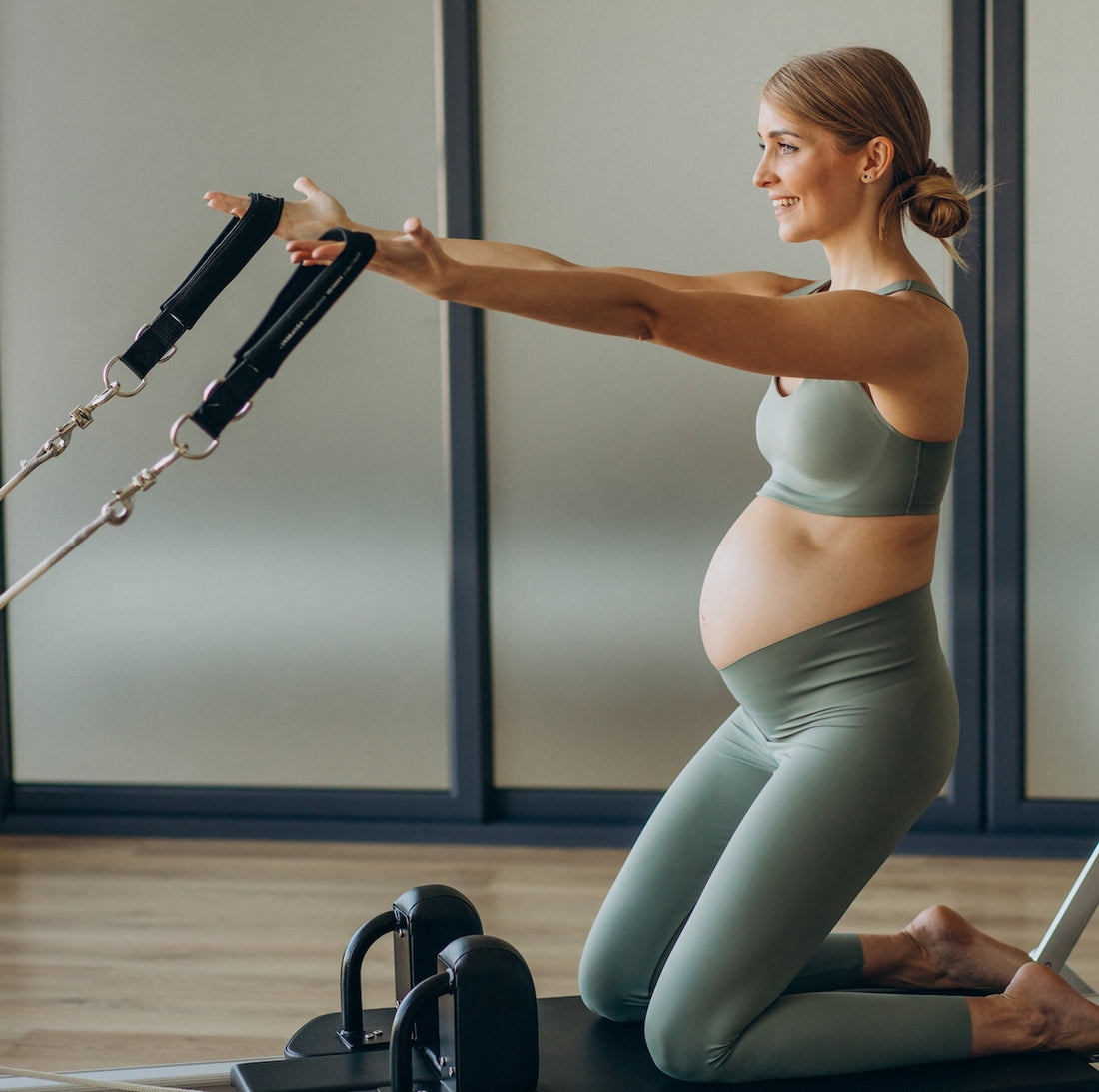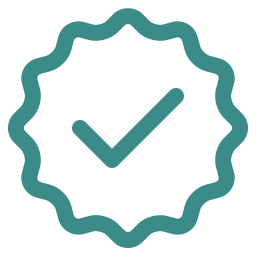Studies have even shown that prenatal exercise and exercise during pregnancy can reduce the instances of cesarean sections, help manage gestational diabetes, and reduce the risk of chronic disease for children when they become adults.
The question then becomes, what is the optimal exercise for pregnant women? Generally, doctors recommend a low to medium-impact exercise focusing on cardio, flexibility and strengthening the pelvic floor.
Pilates is one of the most obvious choices that match these characteristics and generally confers several additional wellness and physical benefits during pregnancy. Further, Pilates on a Pilates reformer machine can compound these benefits, thanks to its sophisticated movements and stability.
So we must ask, how safe is reformer Pilates for pregnancy and how effective is it?
Is Reformer Pilates Safe for Pregnancy?
Pilates on a reformer is absolutely safe during pregnancy and can even be considered safer than exercising on a mat. Since mat Pilates relies on body weight and keeping your center of gravity to balance during exercises, it’s very easy for pregnant women to become dizzy, lose their balance, or struggle during basic exercises.
The Pilates reformer is beneficial for pregnancy because it comes with straps and resistance springs that allow pregnant women to keep their balance, whether lying on their side, knees, or even standing up for some exercises. The Pilates Cadillac takes it a step further, adding everything from multiple straps to adjustable head and shoulder rests for the most comfortable workout to date.
Women can even increase spring resistance during some exercises to maintain their balance when they are acting against gravity.
In terms of benefits, a Pilates reformer may be more beneficial in the long run because many exercises, such as standing side splits, supine arms, and long stretches, all help strengthen your pelvic floor significantly faster than on a mat.
As a result, there are several benefits that pregnant women can get from exercising on a Pilates reformer.
Benefits of Pilates for Pregnancy
Many of the benefits we receive from Pilates, including a stronger pelvic floor, increased blood circulation, and improved flexibility, all help to promote a healthy delivery and lower discomfort throughout the pregnancy.
Studies have shown that Pilates during the prenatal period and pregnancy provides the following benefits:
- Reduced blood pressure which improves the physical and emotional process of labor
- Reduced stress during pregnancy
- Reduced instances of intrapartum perineal trauma
- Stronger pelvic floor muscles
- Improved gestational diabetes management
- Reduced back/pelvic pain during pregnancy
- Improved sleep
Additionally, Pilates during pregnancy also improves the baby’s health as well. As previously mentioned, exercise during pregnancy can reduce the risk of chronic disease for babies later in life and lowers the risk of fetal macrosomia.
Since there is very little risk to the baby from exercising during pregnancy, Pilates is an excellent therapeutic option to improve the health of both the mother and baby.
Pilates Considerations by Trimester
With these benefits in mind, adjusting your Pilates workouts for each pregnancy stage is important to gain the best results for you and the baby.
Generally, prenatal Pilates is the best time to get your high-intensity workouts in and build strength and flexibility.
However, during the first trimester, you’ll generally be able to do all of the same workouts you did before pregnancy, but you should avoid overexerting yourself.
The second trimester is where you’ll mostly have to modify your exercises. First, that baby bump will shift your center of gravity, requiring you to take extra precautions during workouts to avoid falls. Again, this is another reason why the reformer is so useful in these circumstances.
Secondly, you’ll want to avoid exercises where you lie on your back (this could restrict blood flow to the baby if the vena cava is compressed) and any forward-facing abdominal exercises or planks that put tremendous pressure on your abdominal muscles.
Many of the same precautions will apply to the third trimester, but you must avoid overexerting yourself during exercises. Kegels and pelvic floor exercises are recommended because they will prepare you for childbirth and improve your blood circulation.
Additionally, controlled or diaphragmatic breathing will reduce stress and anxiety and improve sleep.
Finally, after giving birth, be sure to wait until your six-month postnatal appointment to see whether you are ready to start exercising again. Of course, returning to your regular Pilates workouts will help accelerate your recovery after delivery and make you feel like your old self again.
With this in mind, we’ve prepared a few tips to help you make the most of your workouts while pregnant and ensure the utmost safety.
Tips for Doing Pilates While Pregnant
1. Consult a Healthcare Professional
First and foremost, consult with your obstetrician to determine which workouts are right for you and the optimal frequency of your workouts.
2. Use a Pregnancy Wedge
As previously mentioned, lying on your back during pregnancy for vigorous exercise can put lots of pressure on the vena cava. To prevent complications and reduce back pain, you can work out with a pregnancy wedge.
There are several pregnancy wedges for Pilates reformer devices that help you maintain stability during exercises and counteract any anterior pelvic tilting.
3. Learn to Keep Your Balance
The Pilates reformer allows you to adjust springs to heavier resistance to maintain greater balance while doing exercises, such as a rolldown, and avoid falls or putting too much strain on your abdominal muscles. In addition, a Pilates reformer with a tower is also helpful because it allows you to keep your balance while standing or kneeling.
4. Take Slow Movements
This leads to our next point: understanding your body and knowing when to take it slow. A Pilates workout during pregnancy should encompass slow, purposeful movements and deep breaths that allow you to clear your head, improve your flexibility, and stretch sore muscles.
Fortunately, with the right Pilates equipment, you can maintain those slow movements without fear of losing your balance.
5. Know What Exercises to Use and Avoid
As much as you need to avoid certain supine and forward leaving abdominal exercises, you also want to avoid exercises with deep crunch movements.
Additionally, you could work with an instructor or trainer to devise a workout plan specifically for your pregnancy timeline. For example, first-trimester workouts may be more focused on abdominal strength, while second and third-trimester workouts may target pelvic floor and lower back muscles.
6. Take Lots of Breaks
The key to a low-intensity workout is knowing when to quit. Take lots of breaks in between workouts and stop if you’re feeling any of the following symptoms:
- Dizziness
- Headache
- Shortness of breath
- Painful contractions
- Amniotic fluid leakage
- Abnormal pain in the chest or abdomen
7. Allow More Time for Recovery
Allow more time between workouts to recover stamina, which may be at a minimum early in pregnancy.
8. Create a Comfortable Environment
Finally, find a way to be more comfortable during workouts. Workouts like hot yoga and other sweat-inducing workouts are not ideal for pregnant women, so engaging in low-impact and slow exercises are important.
Additionally, you want to create an area of relaxation and calmness to reduce stress and improve air and blood circulation throughout the body.
Conclusion
Consider purchasing tight but comfortable clothing that won’t limit your range of motion. Light up some candles if you’re working out at home and work out in a quiet environment.
Since Pilates was designed for physical rehab, it only makes sense that it would be this beneficial for pregnancy.
Furthermore, the Pilates reformer provides the optimal experience for pregnant women, allowing for safe, slow, and purposeful movements that provide better benefits than just working out on a mat. Best of all, a reformer machine can be used long after pregnancy and before your next pregnancy to provide you with all of the benefits listed above.
To find the best reformer for pregnancy and afterward, browse our wide selection at Pilates Reformer Plus. We offer top-of-the-line reformers, including Cadillac reformers, that are comfortable, versatile, and safe for pregnant women.





